Story behind the song…. “It is Well with my Soul”
Note: Copied from The St. Augustine Record at website: www.staugustine.com
Horatio G. Spafford was a successful lawyer and businessman in Chicago with a lovely family – a wife, Anna, and five children. However, they were not strangers to tears and tragedy. Their young son died with pneumonia in 1871, and in that same year, much of their business was lost in the great Chicago fire. Yet, God in His mercy and kindness allowed the business to flourish once more.
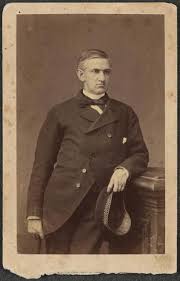
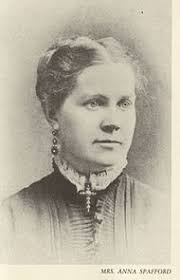
On Nov. 21, 1873, the French ocean liner, Ville du Havre was crossing the Atlantic from the U.S. to Europe with 313 passengers on board. Among the passengers were Mrs. Spafford and their four daughters. Although Mr. Spafford had planned to go with his family, he found it necessary to stay in Chicago to help solve an unexpected business problem. He told his wife he would join her and their children in Europe a few days later. His plan was to take another ship.

About four days into the crossing of the Atlantic, the Ville du Harve collided with a powerful, iron-hulled Scottish ship, the Loch Earn. Suddenly, all of those on board were in grave danger. Anna hurriedly brought her four children to the deck. She knelt there with Annie, Margaret Lee, Bessie and Tanetta and prayed that God would spare them if that could be His will, or to make them willing to endure whatever awaited them. Within approximately 12 minutes, the Ville du Harve slipped beneath the dark waters of the Atlantic, carrying with it 226 of the passengers including the four Spafford children.
A sailor, rowing a small boat over the spot where the ship went down, spotted a woman floating on a piece of the wreckage. It was Anna, still alive. He pulled her into the boat and they were picked up by another large vessel which, nine days later, landed them in Cardiff, Wales. From there she wired her husband a message which began, “Saved alone, what shall I do?” Mr. Spafford later framed the telegram and placed it in his office.
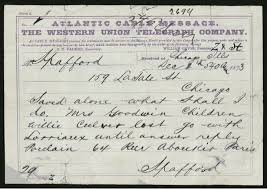
Another of the ship’s survivors, Pastor Weiss, later recalled Anna saying, “God gave me four daughters. Now they have been taken from me. Someday I will understand why.”
Mr. Spafford booked passage on the next available ship and left to join his grieving wife. With the ship about four days out, the captain called Spafford to his cabin and told him they were over the place where his children went down.
According to Bertha Spafford Vester, a daughter born after the tragedy, Spafford wrote “It Is Well With My Soul” while on this journey.
Here are the original words to the hymn:
When peace like a river, attendeth my way,
When sorrows like sea billows roll;
Whatever my lot, Thou hast taught me to know or say
It is well, it is well, with my soul.
Refrain:
It is well, (it is well),
With my soul, (with my soul)
It is well, it is well, with my soul.
Though Satan should buffet, though trials should come,
Let this blest assurance control,
That Christ has regarded my helpless estate,
And hath shed His own blood for my soul.
My sin, oh, the bliss of this glorious thought!
My sin, not in part but the whole,
Is nailed to the cross, and I bear it no more,
Praise the Lord, praise the Lord, O my soul!
For me, be it Christ, be it Christ hence to live:
If Jordan above me shall roll,
No pang shall be mine, for in death as in life,
Thou wilt whisper Thy peace to my soul.
But Lord, ’tis for Thee, for Thy coming we wait,
The sky, not the grave, is our goal;
Oh, trump of the angel! Oh, voice of the Lord!
Blessed hope, blessed rest of my soul.
And Lord, haste the day when my faith shall be sight,
The clouds be rolled back as a scroll;
The trump shall resound, and the Lord shall descend,
A song in the night, oh my soul!
Anna gave birth to three more children, one of which died at age four with dreaded pneumonia. In August 1881, the Spaffords moved to Jerusalem. Mr. Spafford died and is buried in that city.
And the peace of God which surpasses all understanding, shall keep your hearts, your minds through Christ Jesus. – Philippians 4:7.
Extra note: “It Is Well With My Soul” is a hymn penned by hymnist Horatio Spafford and composed by Philip Bliss. First published in Gospel Songs No. 2 by Sankey and Bliss (1876)
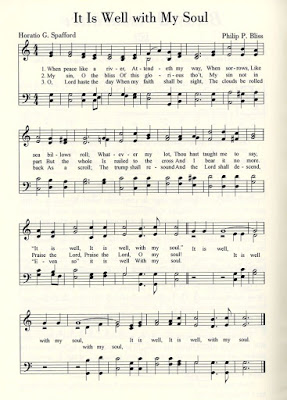
Extra Details on the Ship Wreck:
Collision at Sea
The Ville du Havre initially ran into a storm which made many passengers sick, and then afterwards hit fog for a period of two and a half days. The ship’s Captain, Marius Surmont, was during this dangerous time, constantly on the bridge, and got little if any sleep for three days and nights. He was exhausted afterwards, and once they got away from the fog off Newfoundland, the Captain went to get some sleep in his cabin, leaving the Second Officer in charge.
It was a clear, fine night, and by this time the Ville du Havre was in mid Atlantic where ocean is 3 miles deep. Lights of another vessel could clearly be seen several miles away, but approaching. This was the Lochearn, a British merchantman, built in Glasgow in 1869, which was powered by sail alone. As they approached each other, it was the responsibility of the steamship to take avoiding action. However, at the last minute, an error of judgement caused the steamship Ville du Havre to sail across the bows of the iron clad sailing merchant vessel, which struck her amidships at full speed with devastating effect. The Captain was just coming back on deck after his sleep at the time the bowsprit of the Lochearn crossed the side of the Ville du Havre a split second before the impact. It was shortly before 2am on 22nd November. Captain Marius Surmont immediately ordered the launching of the life boats, and two of the eight were quickly got away, though mostly with crew members aboard. As passengers hurried on deck, many only in their night attire and began to realise their dire plight, the main mast collapsed, destroying several life boats still in their davits, which were already filling with passengers, and the mizzen mast also fell forwards killing a number of people. Then, the bows of the stricken vessel broke away, and sank. The remainder of the hull quickly followed, just twelve minutes after the initial collision, throwing the survivors who were still on deck into the freezing water, and drawing many down after her as she sank.
Rescue boats were immediately launched from the Lochearn, which had hove to nearby. She was badly damaged in the collision, though she was not in immediate danger of sinking. The boats picked up some survivors in the pitch darkness of the early hours, but many in the water perished from the intense cold of the water before they could be rescued. The rescue boats from the Lochearn and the two boats from the Ville du Havre kept searching until 10 o’clock the following morning, but no one was pulled alive from the water after the first hour following the sinking of the Ville du Havre. All those who survived had been plucked from the water by about 3.15am. The Captain went down with his ship, but miraculously escaped the vortex and bobbed back up to the surface, to be dragged half dead into a rescue boat.
The following account of what happened to Anna Spafford and her children is taken from ‘Faith and Fate in Jerusalem’ by Birgitte Rahbek & Mogens Bähncke:
Anna Spafford stood with Tanetta in her arms. The eldest daughter, Annie, could see that she was heavy for her and leant her shoulder into her mother to lend some support. The two other children, Maggie and Bessie, pressed themselves to their mother. Nicolet and Willie Culver were there too, and Pastor Lorriaux kept an eye on the little group. Pastor Weiss ran back down to his cabin and returned with coats and shawls for the children.
Anna Spafford and her little group stood alongside one of the released lifeboats, but terrified passengers forced their way past, pushing the little group aside. At that very moment a shudder went through the ship; the screams became more urgent and the confusion increased. Pastor Weiss thought that there were too many people crowded onto their side of the ship and he began to shout that they must quickly make their way over to the other side. At that moment the mainmast snapped and fell, pulling the mizzenmast down with it. The released lifeboat was catapulted overboard, carrying with it all the passengers who had managed to fight their way onto it.
Things now began to happen very quickly. The Ville du Havre tilted sharply to starboard and began to sink. Anna knew that the end was near, but she was not afraid of dying, and thought only that it would be a comfort for her husband to know that she and the children perished together. There was a moment of silence on board as the deck slowly slid down into the sea. Little Maggie held onto Pastor Weiss’ hand. She looked up at him. “Pray!” she said. “God help us,” replied the priest. Another loud crash was then heard as the bow broke away from the rest of the ship and sank.
Maggie, who up until this moment had been terrified out of her wits, now let go of the pastor’s hand and walked calmly over to her mother, who still held little Tanetta in her arms. Annie continued to lend her support, while seven year old Bessie clung, pale and silent, to her knee. Nicolet and two of the French priests were there too. Maggie turned up her dark eyes to look at her mother, saying; “Mother, God will look after us.” And Annie said: “Do not be afraid. The sea is His, and He created it.”
The sea was now washing over the quarterdeck and, like a chasm, it yawned open up to swallow the crumpled shell of the Ville du Havre. The little group fell together into the water – along with all the others crowded onto the deck. Below deck, inside the ship, there were many who were trapped and unable to do anything to save themselves. All slid into the sea which was several kilometers deep, in a maelstrom, in a rush of fragments of wreckage and human bodies.
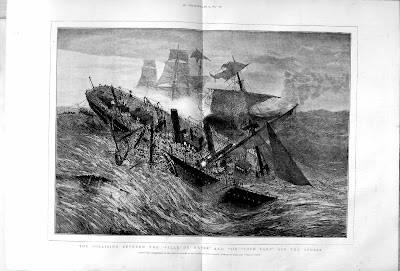
It is not clear what happened to 7 year old Bessie when she was thrown into the sea as the Ville du Havre went down, but we know something of the fate of the other three Spafford girls.
The American passenger Charles Waite, struggling to save himself in the water, saw immediately in front of him the two oldest of the Spafford girls, Annie and Maggie, frantically paddling to remain afloat. Swimming up to them, he invited them both to hang onto the pockets of his coat while he swam. They found a large floating piece of timber and hung onto it for a while, but gradually overcome by the intense coal, the grip of both girls weakened and one after the other, they let go and were lost, Waite himself unable to do anything to save either of them.
Meanwhile Anna had also been precipitated into the water as the ship went down. She was till holding tightly to Tanetta, but a piece of flotsam struck her arm and she lost her grip on the young child who was swept away. Anna found herself carried onto another larger piece of floating timber. Anna clung on in the icy waters for an hour before she was plucked from the water half dead by one of the boats from the Lochearn, and was taken to safety. Later she reported that while still in the water she felt she heard a voice speaking to her ‘you are spared for a purpose. You have work to do.’

Aboard the Lochearn, as the truth gradually dawned on Anna that she had lost all four of her daughters, she became hysterical and tried to throw herself overboard. She was restrained by the faithful pastor Lorriaux who looked out for her from that moment on. Anna reflected aloud on her loss, saying resignedly: ‘God gave me my four little daughters; it is he who has taken them from me. He will make me understand and accept his will.’
The survivors consisted of 33 passengers and 87 crew out of total 135 passengers, together with 6 stowaways, and 172 crew. In the accident, a total of 193 lives were lost, most by drowning, though some died in the initial impact.
Carried To Cardiff
A third vessel, the Trimountain, by the grace of God just happened to be in that area after its American Captain, William Wallace Urquhart (1839-1920), had reset its course. It was travelling on a different bearing than usual, one which brought it directly to the Lochearn by 8am the morning of the disaster. It was also, as a result of an error, only carrying half a payload, and so had an entire deck free to accommodate the unexpected passengers, survivors of the sinking. The Trimountain took most of the survivors off the badly damaged Lochearn, and continued on its journey from New York towards Bristol.
Captain William Urquhart would later be presented with a silver service from the citizens of Bristol, his final destination, to honour his actions in saving the passengers and crew of the Ville du Havre.
He said it was a sad sight to see those broken-hearted people in his cabin. One would say, “I have lost my only daughter;” another, My four little children are buried in the deep;” and another, “My plans in life are all broken up.” One of the saddest sights he ever witnessed was their departure from Cardiff, when draped in black. They wished him farewell, and said they had lost their best friend.
When the survivors arrived in Cardiff, it was a full week since the disaster, and still the news of what had happened was yet to break on an unsuspecting world, and the relatives of those who had been lost were still in ignorance concerning what had happened. Two American passengers were the first to step foot on shore, carried there by a tug boat. They were armed with sheafs of messages to be sent as telegrams as quickly as possible to inform relatives about the disaster. Among the telegrams that were sent in the early morning of 1st December from the Cardiff telegraph office was one from Anna Spafford to her husband. It is often said that the message was just two words: ‘Saved alone’, however, the actual telegram was in fact rather longer, the full text reading as follows:
Saved alone. What shall I do. Mrs Goodwin Children Willie Culver lost. Go with Lorriaux until answer. Reply Porclain 64 Rue Aboukir Paris.
This telegram survives, and was later framed by Horatio Spafford, and put up on the wall of their home at Lake View. It is now kept in the Library of Congress in Washington DC.
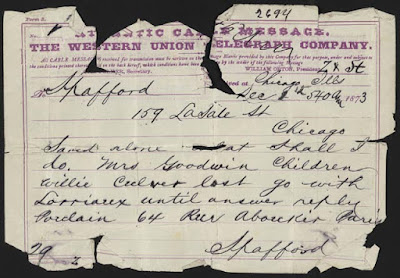
By the time Horaio received the telegram from Anna, sent from Cardiff, she was already in London. His response on hearing the devastating news of the death of his four daughters was reported as being the words: ‘I am glad to trust the Lord when it will cost me something.’ Replying to Anna’s message, he affirmed Anna’s plan to go with Lorriaux to Brtry, and he would join her there as soon as he could. Accordingly, Horatio set off for New York with his friend Daniel Goodwin, who had himself lost his wife and three of his children in the disaster, killed when their stateroom amidships was crushed by the bows of the Lochearn. The two men sailed on the Abyssinia.

